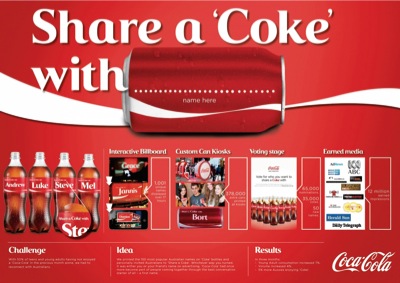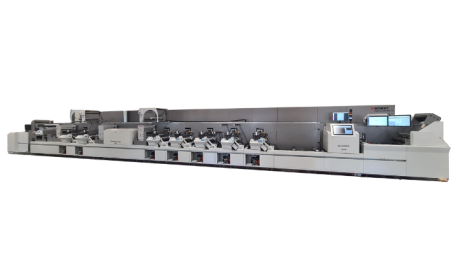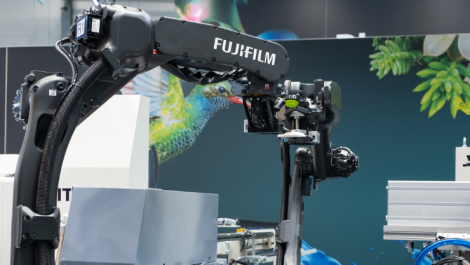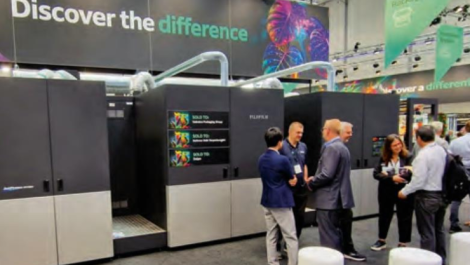It is not just lower cost short runs that are driving the adoption of digital packaging. Brands are using the capabilities to help make consumers feel good about them. Coca-Cola is ahead of the curve and is using digital in innovative ways to boost its already iconic brand. By Sean Smyth.
My niece was back in the UK in February, introducing her two-year-old to the joys of an English winter instead of an Australian summer. There was a family lunch, with several of her friends, and I was struck by the number of customised phone coversaround the table (not mine, of course). Conversation – between texting – suggested there was much warmth shown toward these personalised phones and there was interest in what can be done with many products and packaging.
My niece also told me that she had had her own can of Coke made for her and was delighted by it. And she is not alone. In the summer of 2011, Coca-Cola versioned its bottles Down Under. It chose 150 of the most popular names in Australia and printed them onto bottles and cans with the message, ‘Share a Coke with [name here]’. Initially the versions were released with no publicity and Coke kept quiet about it before a big campaign launch.
Celebrities were sent unique bottles featuring their name to generate more buzz. After the official launch, people could get their name on a giant billboard in Sydney and there was a vote for more names with a further 50 printed up. If your name still wasn’t featured, they set up personalisation kiosks in malls across the country where you could get your own can printed on demand.
During the campaign a total of 378,000 custom cans were digitally produced. In the three months of the campaign, the company saw a 4% increase in sales and this despite it being the wettest summer since records began in 1901. Young adult consumption increased by an impressive 7%, and more significantly, the campaign had people talking about the Coke brand again.
There were 242 pieces of PR recorded, reaching 13.9 million people and traffic on Facebook increased by 870% with 121 million earned impressions on Facebook with fan growth of 39%. Understandably, the campaign is being repeated in New Zealand over this antipodean summer.
Israeli campaign
Another Coca-Cola application was launched in Israel to refresh the company’s Sprite brand. This invites consumers to visit the ‘Refresh Your Sprite’ website and create a can design complete with branding, barcodes and other required information. The campaign attracted submissions from consumers from age 10 to 60 and resulted in more than 100,000 individual can designs.
Each week the public voted for the top 100 designs, which were printed with a case of 24 personalised cans delivered to each winning designer and a second case of 24 put on display in Tel Aviv. The printing for this campaign was carried out by Tadbik Labels of Carmiel, in Israel, using its HP Indigo ws4500 press to print shrink sleeves that were applied to blank cans. ‘While 48 cans doesn’t sound like a lot, the total size of the job was nearly 20,000 shrink sleeves,’ said Oded Shany, managing director of Tadbik.
Mass customisation
Coca-Cola’s Israeli campaign attracted 3.5 million visits to the Sprite website from a population of just 7 million. A similar campaign was run in Brazil with new designs printed in limited editions as the company engages with customers, cementing its image as a cool and inclusive company.
The company followed this up with a whole new level of personalisation by using Facebook to connect with its customers. Here people could create cans featuring their own profile picture which could then be shared with friends and ordered if wanted.
Of course, few brands have the marketing resources of Coke. Individuals have been able to customise their preferred products for many years. Bespoke made-to-measure tailoring has been round for hundreds of years. Specifying your own Levi jeans or Timberland boots is a little newer. Mass customisation as a concept has been successful, and customising the packaging or label is a growing trend.
Most brands are trying to get closer to customers and are always exploring new techniques to engage their targets and generate interest in the brand. One way is to engage customers by providing precisely tailored packs for customers and personalising the pack digitally, this could be a special label on a gift pack or a bespoke carton, sleeve, pouch or can.
Engaging the customer
An innovative combination of agency and digital label company can roll out smaller campaigns, there really isn’t a right or wrong way to manage this media. The Jouw Heineken personalised beer bottles for the Dutch brewery giant was a joint venture between agency and label converter Eshuis who has seen great growth across many countries as the capability broadens.
The mechanism is to use some form of web portal and print on demand digitally and then finish. As the technology becomes established, even a very small company can make a name for itself as an innovative solution provider. These types of approach provide opportunities to talk to customers about building their presence, rather than defending a price.
This is a rapidly growing sector as brands look to promote themselves using digitally produced packaging to create a new dialogue with customers. The market acceptance of personalised packaging is growing and it can be an attractive, regularly repeating business for digital print providers.
The feedback is that price is not a significant part of the negotiation with customers, they are brands looking for ways to connect and cement their relationship with consumers. The volumes of product involved are not high, it is a marketing or promotional expense for marketers to develop their brand. Brands are very keen to appeal to their customers.
Marketers talk about the touch points (any point of interaction between the brand and a consumer) and how they can differentiate themselves from the competition. There are many competing messages and one of the key benefits of social media is a message often will get to the end user via a friend or trusted source.
Being a friend on Facebook or a follower on Twitter is a positive action on behalf of the consumer that tells a brand it is approving. Running campaigns on these platforms is one way to gain approval of the target customer groups. Using digital packaging is proving to be a successful method of driving traffic and creating a buzz.






